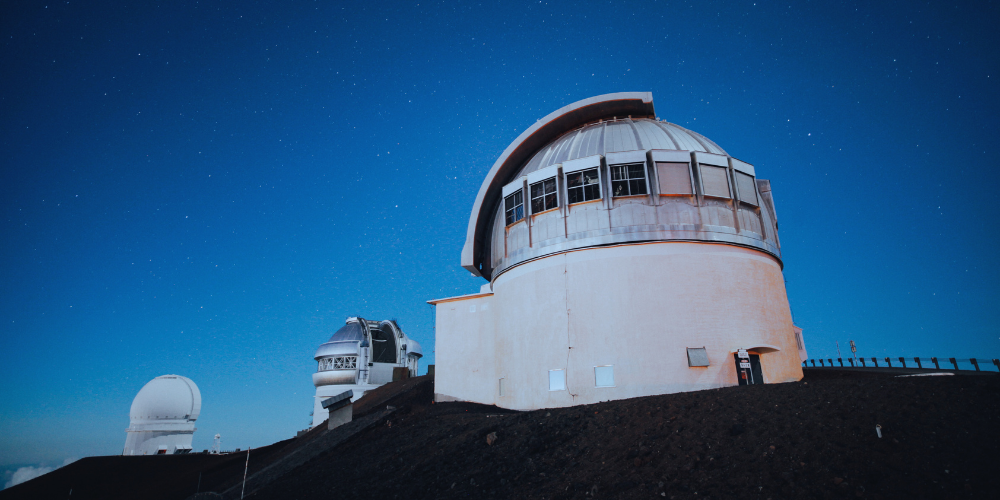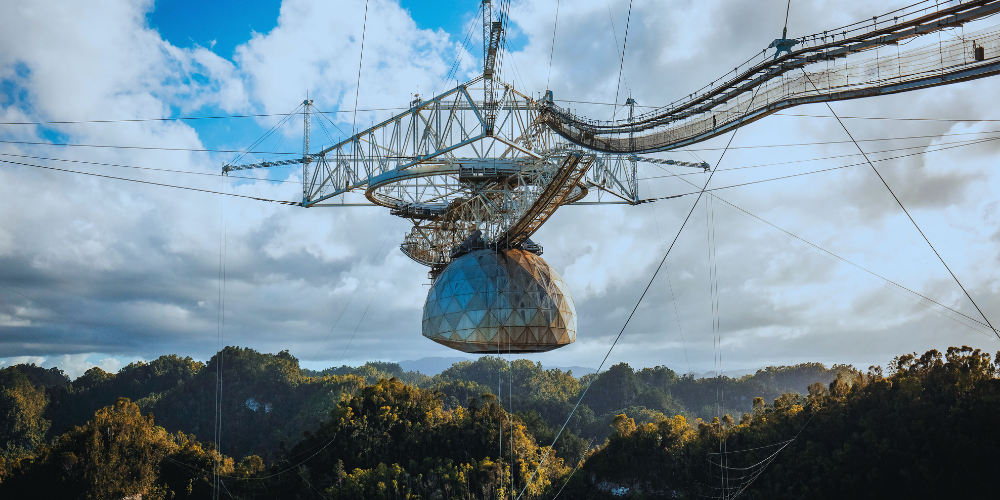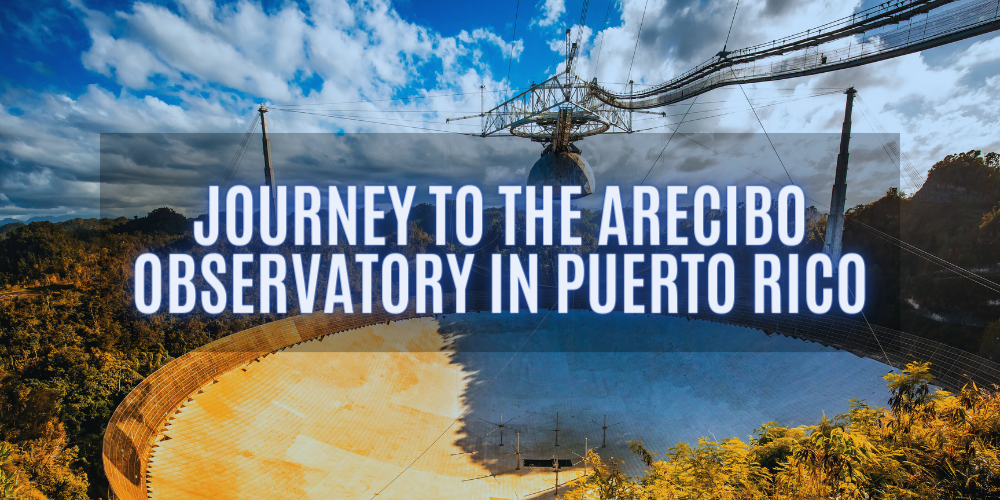Imagine standing at the edge of a vast dish, peering into the cosmos and contemplating the mysteries of the universe. Welcome to the Arecibo Observatory, a monumental feat of engineering and science located in the lush hills of Puerto Rico. Known for its groundbreaking contributions to astronomy and planetary science, the observatory has captured the imagination of scientists and the public alike. This guide will take you through the history, significance, and visitor experience at the Arecibo Observatory, helping you plan a meaningful and unforgettable visit.
History and Significance
Origins and Construction
The Arecibo Observatory was completed in 1963, emerging as a pivotal scientific installation in the heart of Puerto Rico. Built by Cornell University with funding from the U.S. Department of Defense, the observatory’s primary mission was to study the Earth’s ionosphere. However, its capabilities soon expanded to include radio astronomy, radar observations of planets, and the search for extraterrestrial intelligence (SETI).
Scientific Contributions
Over the decades, the Arecibo Observatory has been at the forefront of numerous scientific breakthroughs. It played a crucial role in discovering the first binary pulsar, providing indirect evidence for the existence of gravitational waves—a discovery that earned the Nobel Prize in Physics in 1993. The observatory also contributed to our understanding of planetary systems, studying the rotation rates and surface properties of Mercury, Venus, and various asteroids. In addition, Arecibo’s radar capabilities allowed scientists to map the surface of Venus through its thick cloud cover and study near-Earth asteroids, enhancing our understanding of these potentially hazardous objects.
Cultural Impact
Beyond its scientific achievements, the Arecibo Observatory has made its mark on popular culture. It has been featured in several movies and TV shows, most notably in the James Bond film “GoldenEye” and the sci-fi classic “Contact.” Its iconic status and dramatic setting have made it a symbol of scientific exploration and discovery.

The Visitor Experience
Getting There
Located about 80 miles west of San Juan, the Arecibo Observatory is accessible by car. The scenic drive through Puerto Rico’s countryside takes approximately two hours. Public transportation options are limited, so renting a car is recommended for ease of travel. Ensure your vehicle is equipped for the winding roads leading to the observatory.
Hours and Admission
The observatory is open to visitors from Wednesday to Sunday. Check the official website for the latest hours of operation and ticket prices. Discounts are often available for students, seniors, and large groups. It’s advisable to purchase tickets in advance, especially during peak tourist seasons.
Visitor Center
The Ángel Ramos Foundation Visitor Center is the gateway to your exploration of the Arecibo Observatory. It features interactive exhibits, educational programs, and a small theater where you can watch a documentary about the observatory’s history and scientific achievements. The exhibits cover various topics, including radio astronomy, atmospheric science, and the search for extraterrestrial intelligence.
Highlights of the Arecibo Observatory
The Radio Telescope
The centerpiece of the observatory is the massive radio telescope, once the largest of its kind in the world. Spanning 1,000 feet in diameter, this engineering marvel was used to observe distant galaxies, track asteroids, and study the Earth’s atmosphere. Though the telescope sustained significant damage in recent years, its legacy and remaining structures continue to inspire awe.
Science and Research Exhibits
The visitor center hosts a range of interactive exhibits showcasing the latest research and historical discoveries made at Arecibo. From models of pulsars to detailed explanations of radar mapping techniques, these exhibits provide an in-depth look at the science conducted here.
Observation Deck
The observation deck offers panoramic views of the surrounding landscape and the radio telescope. It’s a perfect spot for photos and provides a sense of the scale and scope of this impressive scientific instrument. Informational plaques around the deck help visitors understand the different components and their functions.
Educational Programs and Tours
Guided Tours
Guided tours are available and highly recommended for a comprehensive understanding of the observatory. These tours, led by knowledgeable guides, cover the history, technology, and scientific achievements of the facility. They typically last about an hour and offer insights that you might miss on a self-guided tour.
Workshops and Events
The observatory hosts various workshops and events throughout the year, aimed at both children and adults. These include stargazing nights, science fairs, and lectures by visiting scientists. Check the observatory’s event calendar to see what’s happening during your visit.
School and Group Visits
Educational trips for schools and large groups can be arranged in advance. These visits often include tailored tours and interactive sessions designed to engage students and enhance their understanding of astronomy and science.

Nearby Attractions
Cueva Ventana
Just a short drive from the observatory, Cueva Ventana offers stunning views from a natural cave opening high above the Arecibo Valley. The hike to the cave is relatively easy and guided tours are available, providing insights into the area’s geology and history.
Arecibo Lighthouse and Historical Park
This family-friendly attraction features a restored lighthouse, historical exhibits, and a small aquarium. The park offers panoramic views of the Atlantic Ocean and is a great place to learn about Puerto Rico’s maritime history. Activities for children, such as a pirate-themed playground, make it an enjoyable stop for families.
Camuy River Cave Park
One of the largest cave systems in the world, Camuy River Cave Park is a must-visit. The guided tours take you through vast caverns and past underground rivers, offering a glimpse into the island’s natural wonders. The park also features picnic areas and a visitor center with exhibits about the cave system’s formation and ecology.
Practical Information
Weather and Best Time to Visit
Puerto Rico enjoys a tropical climate, with warm temperatures year-round. The best time to visit is during the dry season, from December to April, when the weather is most pleasant. However, the observatory is open year-round, and the lush greenery during the rainy season (May to November) offers its own charm. Always check the weather forecast before your trip, as heavy rains can affect travel conditions.
Accessibility
The visitor center and observation deck are wheelchair accessible. If you have specific accessibility needs, it’s advisable to contact the observatory in advance to ensure a comfortable visit. The paths and viewing areas are designed to accommodate all visitors, making the experience inclusive and enjoyable.
Local Accommodations
There are several lodging options in Arecibo and the surrounding areas, ranging from budget-friendly hotels to more luxurious resorts. Consider staying at the nearby Arecibo Inn or the Parador El Buen Café for convenient access to the observatory and other local attractions. For a unique experience, look for eco-friendly lodges or guesthouses that offer a more personal touch.
Dining Options
Arecibo offers a variety of dining options to suit all tastes. From local Puerto Rican cuisine to international dishes, you’ll find something to satisfy your palate. After your visit to the observatory, consider dining at a nearby restaurant such as Salitre Mesón Costero for fresh seafood and ocean views.
The Arecibo Observatory is a testament to human curiosity and the quest for knowledge. Its rich history, scientific achievements, and cultural significance make it a must-visit destination for travelers in Puerto Rico. Whether you’re a science enthusiast or simply looking for a unique experience, a visit to the Arecibo Observatory promises to be enlightening and inspiring.







